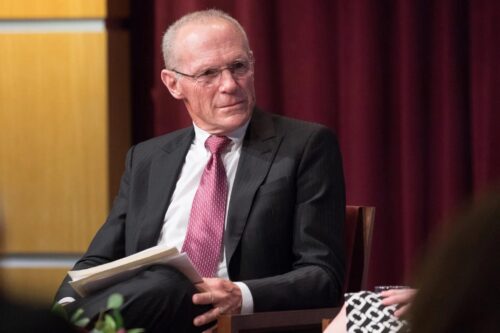
Randall Akee
Director, Project on Indigenous Governance and Development and Julie Johnson Kidd Professor of Indigenous Governance and Development
When Native nations make their own decisions they consistently outperform external decision-makers. Today, we’re answering the question: How can Indigenous governments exercise their sovereignty for better outcomes across the board?
Research from the Project on Indigenous Governance and Development shows that when Native nations exercise their sovereignty it leads to better outcomes across the board —from education to natural resource management. Yet, the path to sovereignty and self-governance isn’t always straightforward.
Our work aims to arm Indigenous people themselves with the tools to build thriving self-governments and strengthen their economic, social, and cultural fabrics. From events to research, we encourage you to explore the below to learn more about how we’re fostering Indigenous governance and nation-building.
Director, Project on Indigenous Governance and Development and Julie Johnson Kidd Professor of Indigenous Governance and Development
Program Director of the Ittapila Program for Nation Building Education and Outreach Endowment at the Project for Indigenous Governance and Development; Lecturer at Harvard Kennedy School
Ford Foundation Professor of International Political Economy, Emeritus
Senior Program Director, Project on Indigenous Governance and Development; Director, Honoring Nations
Video
From setting tribal priorities, to building infrastructure, to managing and sustaining projects, the American Rescue Plan Act (ARPA) presents an unprecedented opportunity for the 574 federally recognized tribal nations to use their rights of sovereignty and self-government to strengthen their communities. As the tribes take on the challenges presented by the Act, the Ash Center’s Harvard Project on American Indian Economic Development hosted a series designed to assist tribes, to help tribes learn from each other and from a wide array of guest experts. During this session, the sixth in the series, following a round of discussion between the panelists a brief Q+A session was held to maximize the opportunities for audience participation.
This session, titled “Investing in Your Tribes’ Infrastructure” featured:
Video
From setting tribal priorities, to building infrastructure, to managing and sustaining projects, the American Rescue Plan Act (ARPA) presents an unprecedented opportunity for the 574 federally recognized tribal nations to use their rights of sovereignty and self-government to strengthen their communities. As the tribes take on the challenges presented by the Act, the Ash Center’s Harvard Project on American Indian Economic Development hosted a series designed to assist tribes, to help tribes learn from each other and from a wide array of guest experts. During this session, the fifth in the series, following a round of discussion between the panelists a brief Q+A session was held to maximize the opportunities for audience participation.
This session, titled “Investing In Your Tribes’ Behavioral Health” featured:
Policy Brief
Video
From setting tribal priorities, to building infrastructure, to managing and sustaining projects, the American Rescue Plan Act (ARPA) presents an unprecedented opportunity for the 574 federally recognized tribal nations to use their rights of sovereignty and self-government to strengthen their communities. As the tribes take on the challenges presented by the Act, the Ash Center’s Harvard Project on American Indian Economic Development hosted a series designed to assist tribes, to help tribes learn from each other and from a wide array of guest experts.
Where do you want to see your nation in 100 years? What decisions in the short and long term will help you achieve this vision? In this session, the fourth in the series, we looked at strategic decision making and the value of long-term planning, investing in human capital, data collection, and how incremental implementation can strengthen your tribe into the future. Each panelist presentation was followed by a brief Q+A session to maximize the opportunities for audience participation.
This session, titled “Strategic Planning and Implementation – How to Pick the Winners and Help Your Tribe” featured:
Video
From setting tribal priorities, to building infrastructure, to managing and sustaining projects, the American Rescue Plan Act (ARPA) presents an unprecedented opportunity for the 574 federally recognized tribal nations to use their rights of sovereignty and self-government to strengthen their communities. As the tribes take on the challenges presented by the Act, the Ash Center’s Harvard Project on American Indian Economic Development hosted a series designed to assist tribes, to help tribes learn from each other and from a wide array of guest experts.
During this discussion, the third in the series, each panelist presentation was followed by a brief Q+A session to maximize the opportunities for audience participation.
This session is titled “A Conversation with Bryan Newland – How Tribes Can Maximize their American Rescue Plan Opportunities” and featured:
Video
The American Rescue Plan Act (ARPA) provides the largest single infusion of federal funding into Indian Country in the history of the United States. More than $32 billion is directed toward assisting American Indian nations and communities as they work to end and recover from the devastating COVID-19 pandemic – which was made worse in Indian Country precisely because such funding has been so long overdue.
From setting tribal priorities, to building infrastructure, to managing and sustaining projects, ARPA presents an unprecedented opportunity for the 574 federally recognized tribal nations to use their rights of sovereignty and self-government to strengthen their communities. As the tribes take on the challenges presented by the Act, the Ash Center’s Harvard Project on American Indian Economic Development presented a series designed to assist tribes, to help tribes learn from each other and from a wide array of guest experts.
This second session, titled “Where Other ARPA Monies Live — How to Avoid Tribes Leaving $12 Billion on the Table” featured a range of experts including:
Media Release
Video
The American Rescue Plan Act (ARPA) provides the largest single infusion of federal funding into Indian Country in the history of the United States. More than $32 billion is directed toward assisting American Indian nations and communities as they work to end and recover from the devastating COVID-19 pandemic – which was made worse in Indian Country precisely because such funding has been so long overdue.
From setting tribal priorities, to building infrastructure, to managing and sustaining projects, ARPA presents an unprecedented opportunity for the 574 federally recognized tribal nations to use their rights of sovereignty and self-government to strengthen their communities. As the tribes take on the challenges presented by the Act, the Ash Center’s Harvard Project on American Indian Economic Development presented a series designed to assist tribes, to help tribes learn from each other and from a wide array of guest experts.
This first session, titled “How Tribal Governments Can and Can’t use ARPA” featured:
Feature
Harvard Project on American Indian Economic Development’s Megan Minoka Hill explains how the American Rescue Plan could bring long-needed aid to Indian Country.
Feature
From the Andes to Washington, D.C., David Cotacachi has spent his life advocating for Indigenous rights and lands.
Media Release
Media Release
Policy Brief
Video
Harvard Kennedy School’s Ash Center and the Harvard Project on American Indian Economic Development hosted a diverse panel of Congressional and tribal leaders to look ahead and discuss how Congress might come together on a bipartisan basis to enhance support for Indian Country’s pandemic recovery efforts.
Policy Brief




